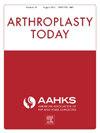大型假体相关感染的时间特异性清创、抗生素、种植体保留和2期翻修:优化窗口期以改善预后
IF 2.1
Q3 ORTHOPEDICS
引用次数: 0
摘要
背景本研究旨在评估巨假体置换术后假体周围关节感染患者的清创、抗生素和植入物保留(DAIR)手术和两阶段翻修手术的结果,包括治疗失败;患者报告的结果;以及确定翻修后巨假体的存活率。方法回顾性研究2018年至2023年间确诊为巨假体置换术后假体周围关节感染的30例患者,随访至少1年。排除了之前在其他机构清创不成功的患者。巨假体植入后4周内就诊的患者接受DAIR手术,4周后就诊的患者接受两阶段翻修手术。主要结果是治疗失败,定义为持续性伤口并发症或需要后续手术干预。次要结果包括通过牛津髋关节评分和牛津膝关节评分评估的患者报告结果,以及翻修后巨假体的存活率。牛津髋关节评分和牛津膝关节评分的平均值分别为(34.22 ± 9.2)和(32.40 ± 8.1)。DAIR手术的成功率为81%(16例中有13例),两阶段交换手术的成功率为71.4%(14例中有10例)。谨慎选择患者和适应症管理是获得最佳效果的关键。本文章由计算机程序翻译,如有差异,请以英文原文为准。
Timing-specific Debridement, Antibiotics, and Implant Retention and 2-Stage Revision for Megaprosthesis-Related Infection: Optimizing the Window Period for Improved Outcomes
Background
This study aimed to evaluate the outcomes of debridement, antibiotics, and implant retention (DAIR) procedures and 2-stage revision surgeries in patients with periprosthetic joint infection following megaprosthesis, including treatment failure; the patient-reported outcomes; and to determine the survival rates of the revised megaprosthesis.
Methods
A retrospective study of 30 patients diagnosed with periprosthetic joint infection following megaprosthesis between 2018 and 2023, with minimum 1-year follow-up. Patients with previous unsuccessful debridement in other institutions were excluded. Patients presenting within 4 weeks of megaprosthesis implantation underwent the DAIR procedure, while those presenting after this window were taken for a 2-stage revision surgery. The primary outcome was treatment failure, defined as persistent wound complication or the need for subsequent surgical intervention. The secondary outcomes included patient-reported outcomes, assessed with the Oxford Hip Score and Oxford Knee Score, and the survival rates of the revised megaprosthesis.
Results
The mean follow-up duration for all patients was 38 ± 12.6 months. Improvement was found for Oxford Hip Score and Oxford Knee Score with mean 34.22 ± 9.2 and 32.40 ± 8.1, respectively, at the 1-year follow-up. DAIR achieved an 81% success rate (13 out of 16) and 2-stage exchange had a 71.4% success rate (10 out of 14).
Conclusions
Both DAIR and 2-stage exchange procedures yielded favorable functional outcomes with satisfactory 2-year survival function. Careful patient selection and indication management are crucial for optimal results.
Level of evidence
Level IV.
求助全文
通过发布文献求助,成功后即可免费获取论文全文。
去求助
来源期刊

Arthroplasty Today
Medicine-Surgery
CiteScore
2.90
自引率
0.00%
发文量
258
审稿时长
40 weeks
期刊介绍:
Arthroplasty Today is a companion journal to the Journal of Arthroplasty. The journal Arthroplasty Today brings together the clinical and scientific foundations for joint replacement of the hip and knee in an open-access, online format. Arthroplasty Today solicits manuscripts of the highest quality from all areas of scientific endeavor that relate to joint replacement or the treatment of its complications, including those dealing with patient outcomes, economic and policy issues, prosthetic design, biomechanics, biomaterials, and biologic response to arthroplasty. The journal focuses on case reports. It is the purpose of Arthroplasty Today to present material to practicing orthopaedic surgeons that will keep them abreast of developments in the field, prove useful in the care of patients, and aid in understanding the scientific foundation of this subspecialty area of joint replacement. The international members of the Editorial Board provide a worldwide perspective for the journal''s area of interest. Their participation ensures that each issue of Arthroplasty Today provides the reader with timely, peer-reviewed articles of the highest quality.
 求助内容:
求助内容: 应助结果提醒方式:
应助结果提醒方式:


